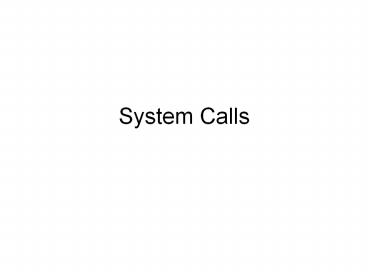System Calls - PowerPoint PPT Presentation
Title:
System Calls
Description:
System Calls. The Linux we use is: Linux-Mandrake 7.0. In this project, you are going to change some kernel files and recompile the kernel. ... – PowerPoint PPT presentation
Number of Views:378
Avg rating:3.0/5.0
Title: System Calls
1
System Calls
2
- The Linux we use is Linux-Mandrake 7.0.
- In this project, you are going to change some
kernel files and recompile the kernel. - After you leave, you should restore the system to
the state before you come. - To do that, make copies of the original kernel
files you want to change. After you are done,
restore these files to their original state. - When you do the project, you can discuss it with
other students. But you must do it by yourself.
3
The System Call Linkage
- A user-space program calls a system call stub,
which contains a trap instruction. - As a result, the CPU switches to supervisor mode
and begins to execute at a specified location in
kernel space. - In the i386 hardware, the trap instruction
actually causes interrupt 0x80 to occur, with the
ISR address pointing at the entry point of the
system_call() assembler routine (see
/usr/src/linux/arch/i386/kernel/entry.S).
4
/usr/src/linux/arch/i386/kernel/entry.S
- .data
- ENTRY(sys_call_table)
- .long SYMBOL_NAME(sys_ni_call) /0/
- .long SYMBOL_NAME(sys_exit)
- .long SYMBOL_NAME(sys_fork)
- .long SYMBOL_NAME(sys_read)
- .long SYMBOL_NAME(sys_write)
- .long SYMBOL_NAME(sys_open)
- .long SYMBOL_NAME(sys_signalstack)
- .long SYMBOL_NAME(sys_sendfile)
- .long SYMBOL_NAME(sys_ni_call)
- .long SYMBOL_NAME(sys_ni_call)
- .long SYMBOL_NAME(sys_vfork)
5
Defining the System Call Number
- System calls are defined in sys_call_table. Thus
when you add a new system call, you need to add
an entry to the table. You do this by editing the
table in the /usr/src/linux/arch/i386/kernel/entry
.S file, as follows. - .data
- ENTRY(sys_call_table)
- .long SYMBOL_NAME(sys_ni_call) /0/
- .long SYMBOL_NAME(sys_exit)
- .long SYMBOL_NAME(sys_ni_call) /190/
- .long SYMBOL_NAME(sys_my_new_call) / 191 /
- .endr
6
- This editing allows a trap (interrupt 0x80) with
an argument of 191 to invoke a new kernel
function, sys_my_new_call(). - You need superuser (su) permission to put the new
version into kernel. - The new system call can be invoked by using the
system call syscall(). Syscall() takes the system
call table entry number and arguments as
parameters and then traps to the kernel.
7
- To generate a system call stub so that an
ordinary C function call will invoke the new
system call, you also need to edit the
/usr/src/linux/include/asm/unistd.h file, as
follows, so that it can be used. - define __NR_exit 1
- define __NR_fork 2
- define __NR_read 3
- define __NR_write 4
- define __NR_open 5
- ..
- define __NR_vfork 190
- define __NR_my_new_call 191
- Finally, you need to generate the system call
stub. These constant definitions are used to
create the system call stub function for use with
C programs for no arguments, one argument, and so
on.
8
Generating a System Call Stub
- The system call stub is generated by using a
macro call from a user-space program. Macros are
available for generating a stub with zero to five
parameters. For example, the macro for generating
a stub with two arguments has the form - _syscall2(type, name, type1, arg1, type2,
arg2) - In this macro, type is the type of the return
value of the system call stub, name is the name
of the stub, type1 is the type of the first
argument, arg1, and type2 is the type of the
second argument, arg2. These macros are defined
in /usr/src/linux/include/linux/unistd.h (which
includes the file /usr/src/linux/include/asm/unist
d.h).
9
- You can generate the stub by making the following
macro call in your user program. - include ltlinux/unistd.hgt
- / Generate system call for int foo(char baz,
double bar) / - _syscall2(int, foo, char , baz, double, bar)
- Also, a system function, system_call(), defined
in arch/i386/entry.S, can be used to invoke a
kernel function (without generating a stub). For
example, if the index in the sys_call_table for
foo() is 193, then you can call the imaginery
foo() function with the following. - include ltsys/syscall.hgt
- syscall(193, baz_arg, bar_arg)
10
Referencing User-Space Memory Locations
- Your function might have a call-by-reference
argument in which the kernel function needs to
write information into a user-space address. - To read or write user-space memory from the
kernel, the kernel first should check to see
whether the address is legitimately defined in
the user virtual address space by using the
following function - verify_area(int type, const void addr, unsigned
long size) - For a read operation, type is set to VERIFY_READ.
For a write, type is set to VERIFY_WRITE. - For example,
- flag verify_area(VERIFY_READ, buf, buf_len)
- If (flag)
- // Error unable to read buf
- Next you can use copy_to_user() to copy the data
from kernel to the user address. - unsigned long copy_to_user (void __user to,
const void from, unsigned long n)
11
Compile the kernel
- How to compile the kernel
- under /usr/src/linux
- make clean
- make oldconfig
- make depend
- make bzImage
- .make clean Removes old relocatable object files
and other temporary files so that your build will - have a clean environement in which it can be
built. - .make oldconfig Defines the logical environment
in which the new kernel should exist. - .make depend many files must be compiled and in
a particular order. make depend creates a file,
linux/.depend, that specifies the compile-order
dependencies. - .make bzImage compiles all the kernel source
code, producing the new image bzImage and save it
- under /usr/src/linux/arch/i386/boot.
12
- Save bzImage to a floppy drive so that you
can use it to reboot and load your new kernel.
The original image - zImage is still there. So even you destroyed
the system, you can still use the original one to
reboot the system. - To save the new Image bzImage on a floppy drive
- cp /usr/src/linux/arch/i386/boot/bzImage
/dev/fd0 - Then you can reboot from the floppy disk.
- reboot































